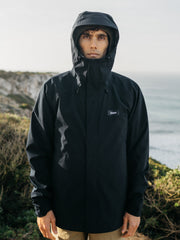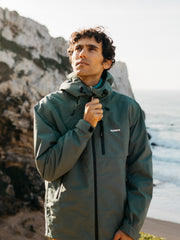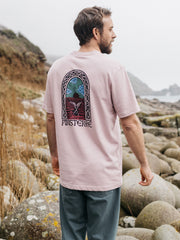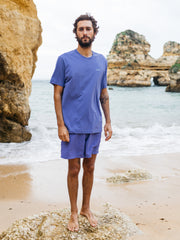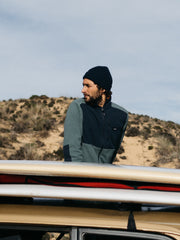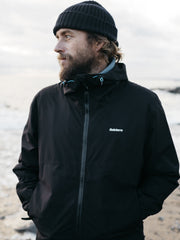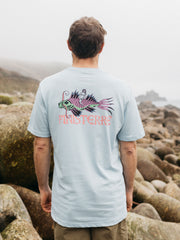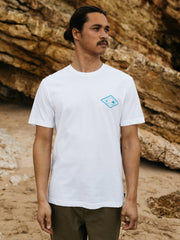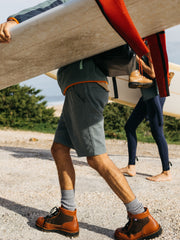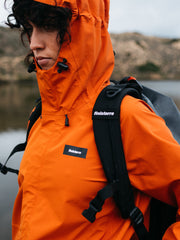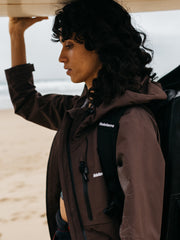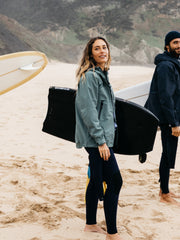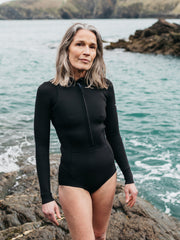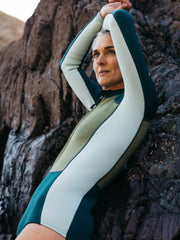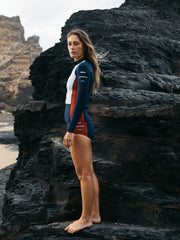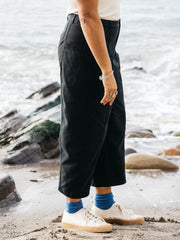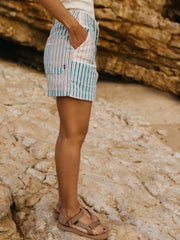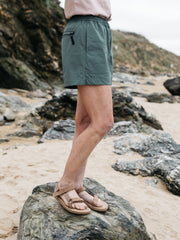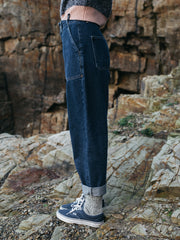Mat Arney looks at the stoic history of lighthouses around the UK. Drawing a comparison between their guardianship of the sea, and how modern surfers should take on these lessons and stand up as stewards of our own marine environments.
The Sentinels: Lighthouses, Surfers & Seven Seas
05.10.23
5 min read
Words & Photography by Mat Arney
In plain sight: What seafarers avoid is often what surfers seek. Sizeable long period groundswell breaking at Godrevy.
In 1698, Henry Winstanley built the first Eddystone lighthouse out of wood on a lonely rock in the English Channel, nine miles south of Rame Head on the approach to Plymouth. A few winters later, the sea smashed it and washed it away, along with Winstanley himself. It was rebuilt, this time in oak and iron. That one burned down. It was rebuilt a third time, this time from interlocking granite blocks like the three little pigs’ houses all rolled into one. That one stood for over a century until it was replaced in 1882, and there is still a lighthouse on Eddystone Rock keeping mariners safe night after night.
The sea takes no prisoners. King Canute and many after him learned that the hard way. It demands respect, and if you don’t show it then the results can be deadly. Luckily, lighthouses are built out of a deep respect for the sea and all that it can do. Perhaps that’s why the water permits them to stand sentinel on some of the most remote, wild, and perilous outcrops around our coasts.
A Lonely Light: Bishop Rock Lighthouse, The Isles of Scilly.
Beacons have been lit on coastlines to guide and to guard for millennia; first on cliffs and high ground, and later on purpose-built structures, the first and most famous of which being The Great Lighthouse, Pharos of Alexandria, which was built almost 500 years BC and towered 450 feet above sea level.
It was one of the Seven Wonders of the Ancient World. Since then, spreading around and out of the Mediterranean as the classical civilizations expanded and developed trade by sea, lighthouses now illuminate the way around the coast of every continent. Along particularly busy and important maritime trade routes seafarers will rarely be out of sight of a light, the flashes passing mariners from the care of one lighthouse to the next as they make their way along a coastline like a dancer being transferred from the hands of one partner to the next at a ceilidh.
Santa Cruz Harbour Mouth, where the man-made has tried to triumph over the natural, and consequently requires a warning light.
Built for the safety of all mariners, lighthouses are significant for surfers, too. Whilst not always in plain sight as we sit on our boards in the bays, coves and beaches between headlands, surfers seek out for fun the swell-exposed coastlines and shallow reefs that seafarers fear.
There are many surf spots around the world that are overlooked by lighthouses – some have become synonymous with one another, like Godrevy, Farol da Nazaré, Cape Byron, Phare de Biarritz or Montauk Light at the tip of Long Island. Others are like Western Australia’s Cape Naturaliste and Cape Leuwin lighthouses: out of sight and out of mind of the world-class surf spots between them, but the goal posts through which every Southern Ocean swell scores. These architectural oddities may be more associated with sailors than with surfers, but their presence on the periphery of our pastime is hard to ignore.
Finisterre ambassador Sam Bleakley perched in sight of Longships Lighthouse, West Penwith.
Surfers don’t need lighthouses. We simply tend to occupy the same coastal spaces because surfers seek out the very convergences of oceanography, meteorology and geology that others avoid. But we do, every last one of us, surfers or not, need guidance and warning of danger in our day-to-day lives. For most humans that guidance and warning doesn’t often come in the form of a physical structure, a flashing light or the blast of a foghorn. It’s usually knowledge that’s communicated to us: “Try it this way,” or, “Be careful of that.”
With the development of modern navigation aids, physical beacons are no longer hugely necessary for all but the most committed of self-sufficient and satellite-free sailors. They are now more often than not landmarks, rather than navigational necessities. The irony is that lighthouses were built to protect us from the ocean. Right now though, it’s the ocean that needs protecting from us. Humanity’s impact upon our environment is irrefutable and the ocean has been hiding its suffering out of sight beneath the surface. And if the sea dies, we die.
Perhaps one of the most famous lighthouses of the surfing world, Farol da Nazaré is often overshadowed by the giant waves that break beneath it.
Lighthouses now stand as a physical simile for the science of climate change. Imagine, if you will, climate science as the lighthouse flashing facts in an attempt to guard us against increasingly frequent and ferocious storms. Scientists and activists are the lighthouse keepers trying desperately to warn us clear of the rocks. It is not just mariners they are protecting however, but all life.
“I can think of no other edifice constructed by man as altruistic as a lighthouse. They were built only to serve.”
George Bernard Shaw
There are some striking similarities between lighthouses and climate scientists; both require huge levels of determination, ingenuity, intellect, and above all, resilience. Lighthouses get battered by the sea and the storms. Climate scientists, educators and activists get battered by deniers and naysayers, and by the huge scale of the task at hand.
If those who represent the people don’t act for the Ocean, then the people will stand for the ocean at the seat of power.
Through 2023 so far we have experienced the hottest three months ever recorded with simultaneous record-breaking global average daily sea surface temperatures and marine heat waves that are akin to wildfires for the plants and creatures that call the ocean home. At the start of April the highest ever reading of atmospheric CO2 in human history was recorded. The latest report by the UN’s IPCC (Intergovernmental Panel on Climate Change) published on Monday 20th March 2023, the IPCC AR6 synthesis report, is effectively the last due to be published whilst there is still a slim chance of limiting warming to 1.5 degrees above pre-industrial levels. This report is all of humanity’s 18,600 lighthouses shining together as one, clear and bright through the storm. It is an urgent call for all hands on deck and a clear message to the captains of countries and industries: alter your course immediately or be wrecked upon the rocks.
There are no lifeboats on Planet Earth. Let’s save this ship.
Lighthouses aren’t the only instances when red and white are used as warning colours.


